Side Menu:
Chief Purser Hugh McElroy
- Evacuation

First Class Stewardess Annie
Robinson saw McElroy with
Captain Smith.
Although unconfirmed, there are accounts that place McElroy in his cabin when the Titanic collision occured: "McElroy, after doing his rounds to pick up the day’s receipt from the various bars and the Marconi room, was in his cabin on C Deck when they struck the iceberg, but shortly sought Captain Smith to discover what was happening." ("Titanic Hero Hugh McElroy: 'Sand For Breakfast Tomorrow' " by Joe Gannon, The Wild Geese.)
McElroy, as Chief Purser, was likely contacted by Captain Smith almost immediately after Titanic's collision with an iceberg. In fact, an early sighting post-collision was by Annie Robinson, a First Class Stewardess, who saw "after the collision about half-an-hour...the mail man passed along first and he returned with Mr. McElroy and the Captain and they went in the direction of the mail room." (British Inquiry). This was approximately 12:10am when Captain Smith and Thomas Andrews inspected the ship. She also saw two mail-bags and a man's Gladstone bag, and on looking down the staircase I saw water within six steps of coming on to E deck." Gladstone bags were used by pursers, so another indication McElroy was involved.
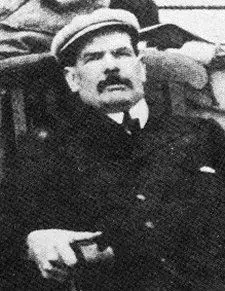
First class bedroom steward
Henry Etches saw McElroy with
"a large group of ladies" at the
pursers office
As the severity of the situation was being accessed, McElroy's initial instructions were for passengers to return to their rooms, but have their lifebelts on according to Henry Samuel Etches, a first class bedroom steward who saw McElroy at the Purser's office with a large group of ladies: "The purser was standing outside of his office, in a large group of ladies. The purser was asking them to do as he asked them, and to go back in their rooms and not to frighten themselves, but, as a preliminary caution, to put the life belts on, and the stewards would give them every attention. Mr. Andrews said: "That is exactly what I have been trying to get them to do," and, with that, he walked down the staircase to go on lower D deck. That is the last I saw of Mr. Andrews." (US Inquiry)
Another who spotted McElroy on C deck, was James Johnstone, a night watchman in the first saloon: "I walked up through the companion, and I saw Mr. Latimer, the Chief Steward. You could not make any mistake about him, he was too big. There was Mr. McElroy and the purser standing by the officers, and two or three officers on C deck."" (British Inquiry)
Although McElroy had almost undoubtedly been in contact with the Captain, early in the proceedings he perhaps was unaware of exactly how serious the situation was, according to an account by Storekeeper Frank Prentice:
"Mr. Prentice emphasises the wonderful presence of mind that prevailed amongst the ship's officers, mentioning that just before he left Mr. McElroy, the purser, to go on deck to see about the boats he had been engaged in provisioning, Mr. McElroy inquired if everything had been locked up below, meaning the store rooms; thus indicating that he had no idea how seriously the ship had been injured." (Western Daily Mercury, 30 April 1912, “Titanic – The Homecoming” “Tales from the Lapland” by Dr. Paul Lee)
Order to go to lifeboats

Assistant Second Steward
Joseph Wheat was told
by McElroy to "get all
lifebelts and all passengers".
At 1205am, after Captain Smith and Thomas Andrews had inspected the ship, the Captain orders the officers to ready the lifeboats and to get passengers wearing lifebelts. Henceforth, McElroy's instructions changed to match this, with his orders now to put on warm clothing and be ready to embark in the lifeboats.
Assistant Second Steward Joseph Thomas Wheat in Second Class said that he "proceeded up the stairs on to C deck. I had to pass D first, and before I got to C, Mr. McElroy was looking over the banisters…He saw me coming and told me to get the men up and get all lifebelts and all passengers." (British Inquiry)
First class passenger Mrs Eleanor Geneviève Cassebeer: "The pursers started to go among the passengers ordering them to go below and put on warm clothing and be prepared to embark in the lifeboats. I hurried below and dressed and when I came on deck again I found that the deck had started to list in a very alarming manner." (Binghamton Press, 29th April 1912)
Valuables

Dr. Washington Dodge reported the
"purser's office surrounded by a
crowd demanding their valuables"
With it now looking likely they would be exiting the ship in lifeboats, there was a sudden rush on the Purser's office for valuables. Dr. Washington Dodge later said: "It was related to me by a women in my lifeboat that just before who came on deck and got onto the boat, she saw a purser's office surrounded by a crowd demanding their valuables which the purser and his assistant were endeavoring to hand out as quickly as possible. In this crowd were many women. I believe", (San Francisco Chronicle, May 12, 1912)
Other reports added McElroy then locked the safe and did not allow valuables to be retrieved: "Chief Purser Hugh McElroy told the Countess of Rothes 'I am glad you did not ask me for your jewels as some ladies have', he then closed the Purser's Office during the evacuation and advised all the women not to worry about their valuables, but to put on their lifebelt's and report to the lifeboats. Before the purser left his station, he locked the safe, so no opportunist thief would take anything. Hugh and his staff had retrieved valuables from most of the Purser's safes and were distributing valuables to their owners as the lifeboat’s got filled." (The Life and Times of Hugh Walter McElroy, Chief Purser of R.M.S. Titanic, by Frank McElroy).
In another account McElroy allegedly told the Countess of Rothes to hurry: "He closed the office urging people to get on their life belts and get to the boats. When Noël Leslie, the Countess of Rothes, hesitated, McElroy urged her to go saying, 'Hurry, little lady, there is not much time.'" ("Titanic Hero Hugh McElroy: 'Sand For Breakfast Tomorrow'"" by Joe Gannon, The Wild Geese.)
Lawrence Beesley indicates that he heard the sound of the safe door in the purser's office on F deck (although it was actually on E deck): "Coming upstairs again, I passed the purser's window on F deck and noticed a light on inside; when halfway up to E deck, I heard the heavy metal clang of the safe door, followed by a hasty step retreating along the corridor towards the first-class quarters. I have little doubt it was the purser, who had taken all the valuables from his safe and was transferring them to the charge of the first-class purser, in the hope that they might all be saved in one package." ("The Loss of the SS. Titanic", by Lawrence Beesley)
Gladstone bags

First-class steward Frederick Ray 'saw the
two pursers at the safe taking things out
and putting them in bags'.
Although Frank McElroy is certain that the Chief Purser worked hard to return valuables to their owners: "I strongly believe the references that Chief Purser McElroy had worked hard to return valuables to evacuating passengers as much as was possible… On the night of the sinking, the pursers diligently removed a large number of those valuables from the safe, putting them into leather “Gladstone” handbags for evacuation in the Ship’s lifeboats." ( The Life and Times of Hugh Walter McElroy, Chief Purser of R.M.S. Titanic, by Frank McElroy).
"Gladstone bags" were often used by Pursers and there is some evidence that the Pursers used them to secure money and jewellery for passengers to empty safes during the sinking. First we have first-class steward Frederick D Ray who say the pursers putting things in bags: "I walked leisurely up to the main stairway, passed two or three people on the way, saw the two pursers in the purser's office and the clerks busy at the safe taking things out and putting them in bags.(US Inquiry)
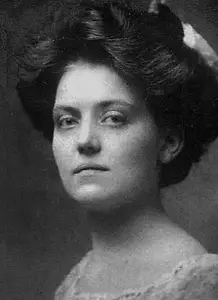
Stewardess Violet Jessop described
a purser's gladstone bag on the boat
deck "filled with gleaming gold
sovereigns" and being knocked over.
As a form of confirmation of pursers using Gladstone bags we have a dramatic account by stewardess Violet Jessop in her memoirs in which she described a bag on the boat deck: "An open gladstone bag, filled with gleaming gold sovereigns. The man who had brought it up came from the purser's office. He was taking a breather, for it was very heavy and he yet had to move it to a lifeboat. Somebody passed by hurriedly and kicked the bag in passing. Some of its precious cargo scattered, to the mortification of the man in charge. As he tried to rescue the coins from under moving feet, his mate came up with heavy dispatch box and joined them. ("Titanic Survivor - The Memoirs of Violet Jessop Stewardess", Violet Jessop).
Indeed, Gladstone bags have been recovered from the wreck site, including one from the RMS Titanic Inc 1987 recovery mission. The Gladstone bag contained a cache of precious contents, including a handmade platinum, 18-karat gold and diamond filigree ring; a gold ribbon brooch with diamonds; and a set of men's gold cufflinks and studs embellished with green enamel. “The majority of the best-of-the-best, high-end pieces came from the Gladstone bag,” Alexandra Klingelhofer, vp of collections for RMS Titanic, Inc., told Forbes. “They’re beautiful, explicit, Edwardian pieces.” (Source: Forbes article).
According to a 2012 Reuters article "many of the jewelry pieces, recovered from the wreck in 1987, were found in a leather bag that had likely been in the care of a ship’s purser, an employee responsible for handling money and other valuables, Klingelhofer said."The purser likely removed the jewelry from a safe on the Titanic as the ship was sinking and placed them in leather bags so that he could return them to their owners after the rescue, she added. “But there were no pursers that were rescued,” Klingelhofer said. (Source: Reuters News article)
According to Frank McElroy one of the Gladstone bags recovered in 1987 "contained $65,000 in bank notes, over 300 gold sovereigns, a very large amount of jewellery and 2 gold watches." ("The Life and Times of Hugh Walter McElroy, Chief Purser of R.M.S. Titanic", by Frank McElroy).
Purser's Safe recovered
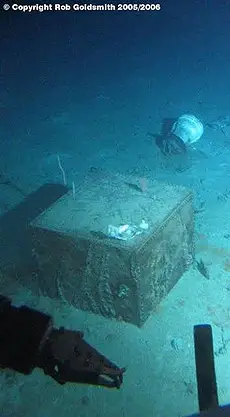
Above: The Purser's safe was discovered in the debri field in 1987.
(Click image to enlarge)
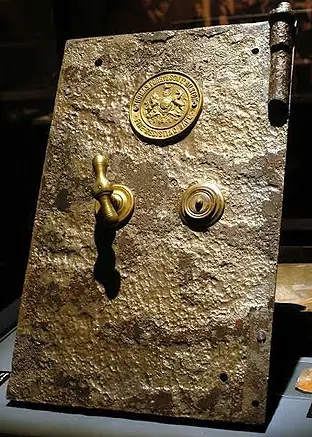
Above: The Purser's safe now on display.
(Click image to enlarge)
In 1987 a Purser's safe and a satchel were raised and opened on live television from Paris, France in a show hosted by Telly Savalas entitled "Return to the Titanic" revealing "soggy bank notes, coins and jewelry, including a gold pendant with a small diamond and the inscription, 'May This Be Your Lucky Star'…A purser’s safe brought up from the wreck last summer contained an assortment of gold-colored British coins, whose value was estimated by an expert at about $5,000.” The leather satchel was also opened to reveal "jewelry, a watch, wads of American currency and an object--possibly a stickpin case--with the initials “R.L.B.”" as well as a a bracelet with the name ″Amy″ spelled in tiny diamonds (Source: LA Times)
The initials RLB were firstly thought to belong to Richard L. Beckwith, a first-class passenger who escaped the sinking ship on a lifeboat with his wife, however the contents of the bag were so diverse it was later decided it most likely belonged to McElroy's colleague - Assistant Purser Reginald Lomond Barker.
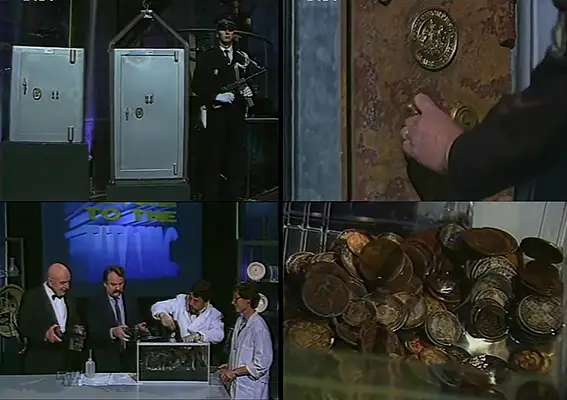
The recovered purser's safe was opened on live TV on 29th of October 1987.
(Click image to enlarge)
The Boat deck
Assistant Second Steward Joseph Thomas Wheat remembes McElroy giving the order to go to the boat deck. "I heard that instruction given by Mr. McElroy about a quarter-past twelve, or round about that time; he sent us down to Mr. Harding to get lifebelts on the passengers and get them on deck… when I got the order from Mr. McElroy again to get all the men to the boats - to their stations." (British Inquiry)
Bedroom steward Henry Etches also remember the order being given to get to the boat deck: "I went along to the purser's place. He said, 'It is necessary to go up on the boat deck,' and he said, “Tell all the other bedroom stewards to assemble their passengers on the boat deck and stand by.' I went on the boat deck, and they were just loading boat No. 7. I said to the quartermaster, 'Is this boat No. 5 '? He said, 'No; it is the next boat.' (US Inquiry)
Chief Second class steward John 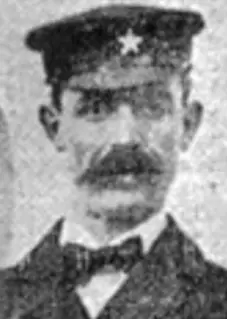
Hardy reported an order "to get the
people on deck" from the pursers
who "are our superiors."
The same instruction was coming from Purser Barker in second class. Chief Second class steward John Hardy said that he went "forward to see what water she was making, and on my return to my end of the ship I met Purser Barker... He advised me or told me to get the people on deck with their life belts on as a precaution. Immediately I sent down for all hands to come up." (US Inquiry) The order was likely directly from the bridge and quite soon after the collision according to Hardy: "Within five minutes after the collision... From Purser Barker; that is Purser Barker brought it himself personally to me... to the two pursers. There is a first-class purser and a second-class purser. They would get it direct from the bridge, I presume. They are our superiors aboard the ship, and we take our orders through them."(US Inquiry)
Before appearing on the boat deck, McElroy was spotted on A deck: Samuel Rule bathroom steward told the British Inquiry, "as I passed up the staircase, I got to A deck and I saw Mr McElroy the Chief Purser and Mr. Dodd, the Second Steward They were in deep conversation. I thought to receive some orders from them, but there were no orders given, and I passed onto the next deck, the boat deck…”. (British Inquiry)
Lifeboat no.9
Later McElroy was then spotted on the boat deck itself, most notably at lifeboat no.9, on the starboard side, with two separate accounts placing him there in an active role.
Saloon Steward William Ward testified at the United States Inquiry shortly after the disaster:
"Then I went aft to No. 9 boat. Mr. Murdoch, the chief officer. Purser McElroy was there, and Mr. Ismay. I do not think any other officers that I saw were there. I went to No. 9 boat and assisted to take the canvas cover off of her. Then we lowered her down to level with the boat deck, and a sailor came along with a bag and threw it in the boat…I think the purser - I am not sure on that point - said "Are you all ready?" Haynes answered "Yes" - it was either the purser or Mr. Murdoch - and with that he said: "Pass in the women and children that are here into that boat." There were several men standing around, and they fell back, and there was quite a quantity of women and children helped into the boat; The purser told two more men to get in and assist these women down into the boat. From the rail of the boat it is quite a step down to the bottom of the boat, and in the dark they could not see where they were stepping. Then the purser told me to get into the boat and take an oar… the purser put me in that boat…. He asked me if I understood anything about it. I said "I understand a little about it." and he said, "Get in there."… Purser McElroy… Mr. Ismay at boat No. 9… I heard him say, "Steady, boys," or something like that - it was some expression like that - when he was standing talking to Mr. McElroy." (US Inquiry)
Although perhaps there is some doubt whether it really was McElroy as when Senator Fletcher asked Ward "Who called out for the women that were to get in the boats? Who called for the women?" Ward responded: "I think it was Chief Officer Murdoch. I would not be sure whether it was him or the purser. They were both tall men, and I would not be sure which one it was. It was dark, you know." (US Inquiry)
However we do have another eyewitness account confirming his presence at no.9, bath steward James Widgery who said:
When I got up there, it was just about to be lowered. The purser sent me along to No. 9. They had taken the canvas off of No. 9 and lowered it, and just then some biscuits came up from the storekeeper. I helped him put one of the boxes into the bottom of the boat, and the purser took hold of my arm and said, "Get in the boat." He said, "Get in the boat and help the boatswain's mate pass the ladies in." So I got in the boat, and stepped on the side, and we passed the ladies in. We thought we had them all in, and the purser called out, "Are there any more women?" Just then some one said, "Yes." This woman came along, rather an oldish lady, and she was frightened, and she gave me her hand. I took one hand, and gave it to the boatswain's mate, and he caught hold of the other hand, and she pulled her hand away, and went back to the door and would not get in.(US Inquiry)
Collapsible C and shots fired
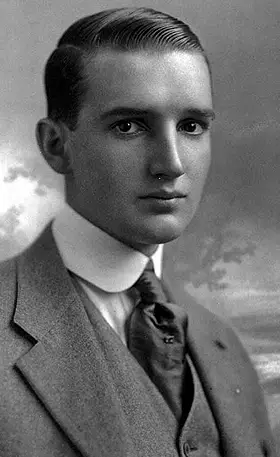
Jack Thayer described McElroy "as brave and
as fine a man as ever lived...fired twice into
the air"
In one of the last sightings of McElroy he was spotted during a disturbance loading the last two forward startboard boasts. In his 1940 memoirs "The Sinking of the S.S. Titanic", John "Jack" Borland Thayer jr claims to have seen Purser McElroy firing a weapon "twice into the air" to stop a rush on collapsible C at around 2am. As a 17 year old first class passenger, Thayer Jr would have been familiar with the Chief Purser, who interacted far more with the passengers than the officers:
There was some disturbance in loading the last two forward starboard boats. A large crowd of men was pressing to get into them. No women were around as far as I could see. I saw Ismay, who had been assisting in the loading of the last boat, push his way into it. It was really every man for himself. Many of the crew and men from the stokehold were lined up, with apparently not a thought of attempting to get into a boat without orders. Purser H.W. McElroy, as brave and as fine a man as ever lived, was standing up in the next to last boat, loading it. Two men, I think they were dining-room stewards, dropped into the boat from the deck above. As they jumped, he fired twice into the air. I do not believe they were hit, but they were quickly thrown out. McElroy did not take a boat and was not saved. I should say that all this took place on “A” deck, just under the boat deck. ("The Sinking of the S.S. Titanic", Jack Thayer)
'Goodbye, old man'
One of the last sightings of McElroy was by Second Officer Lightoller, who knew McElroy personally. He described him as being "very friend with" and knowing him "intimately, ashore and afloat." Lightoller saw him "walking around with his hands in his pockets".
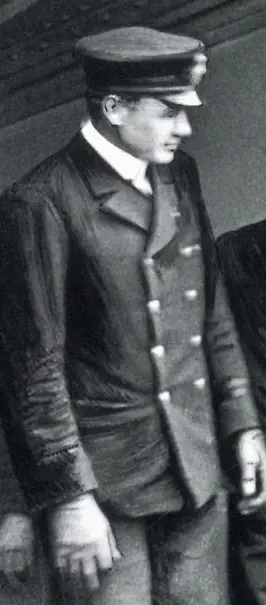
Second Officer Lightoller described
McElroy as "walking around with his hands
in his pockets."
The purser - as a matter of fact, both the pursers - and the pursers' assistants, of whom I believe there were four - two pursers and four assistants, and two doctors, were there. Both pursers I was very friendly with, and knew them both intimately, ashore and afloat. They were both thoroughly capable men. I draw the conclusion that everyone was notified, by the manner and under the circumstances under which I met them last. It was obvious to me that everything with regard to their duty had been done by the mere fact that shortly before the vessel sank I met a purser, Mr. McElroy, Mr. Barker, Dr. O'Loughlin, and Dr: Simpson, and the four assistants. They were just coming from the direction of the bridge. They were evidently just keeping out of everybody's way. They were keeping away from the crowd so as not to interfere with the loading of the boats. McElroy, if I remember, was walking around with his hands in his pockets. The purser's assistant was coming behind with the ship's bag, showing that all detail work had been attended to. I think one of them had a roll of papers under his arm, showing that they had been attending to their detail work. That is why I draw the conclusion. They were perfectly quiet. They came up to me and just shook hands and said, "Good-bye, old man." said good-bye to each other, and that is all there was to it. (US Inquiry)
In his book "Titanic and other ships," Lightoller gave some more detail:
“Just before launching the last two lifeboats, I had made my final hurried visit to the stairway. It was then conclusively evident that not only was she going , but that she was going very soon, and if we were to avoid the unutterable disgrace of going down with lifeboats still hanging to the davits, there was not one single moment to lose. Hurrying back to the two remaining lifeboats still hanging in their davits, I met the Purser, Assistant Purser, and the Senior and Junior surgeons—the latter a noted wag—even in the face of tragedy, couldn’t resist his last mild joke, “Hello, Lights, are you warm?” The idea of anyone being warm in that temperature was a joke in itself, and I suppose it struck him as odd to meet me wearing a sweater, no coat or overcoat. I had long since discarded my great coat, even in pants and sweater over pyjamas alone I was in a bath of perspiration. There was only time to pass a few words, then they all shook hands and said, “Good-bye.” Frankly, I didn’t feel at all like “Good-bye,” although I knew we shouldn’t have the ship under us much longer..” ("Titanic and Other Ships," Charles Lightoller)
In another, account of this conversation, there was even humour: "Dr. O’Loughlin had a lifejacket in his hands. He tossed it aside and said to the others, "I don't think I'll need to put this on." He had once told his friend, Dr. Edward Titus, that the only way he wanted to be buried was, “to be placed in a sack and buried at sea.” He was about to get his wish, minus the sack. The men shook hands all around, knowing the odds of any of them living were very slim. The last words Lightoller heard from McElroy were, “Good-bye, I wish you luck. Well, it looks as if we will have sand for breakfast tomorrow.” ("Titanic Hero Hugh McElroy: 'Sand For Breakfast Tomorrow'"" by Joe Gannon, The Wild Geese.)
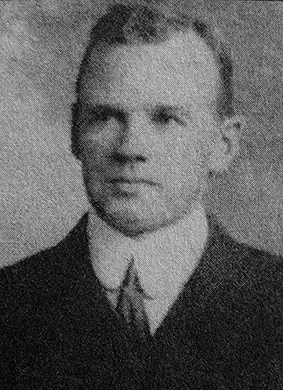
Lightoller was reported as claiming that McElroy
said "it looks as if we will have sand for supper
tonight."
The latter remark, of having "sand for breakfast tomorrow" comes from a private remark Ligtholler made in New York club. John Smith the chief steward at the New York club for officers of the International Mercantile Marine, wrote a letter to Hugh Smith in Portrush, Co Antrim, in late April 1912 (the letter has become known as the "Portrush letter") in which he recounted private comments made by Second Officer Lightoller:
"Mr McIlroy [sic], the purser, had quite a sum of money for me, but I'd give a great deal more to see his genial smile again. He was a fine big-hearted Galway man [actually Liverpool Irish], and a prince to boot. Mr Lightoller told me that the last time he spoke to Mac, he said: 'Well, it looks as if we will have sand for supper tonight.'
I don't think he (McElroy) got down so far, for he was a clean big fellow." (Northern Constitution, May 11th 1912 edition, page nine)
None of the pursers, as described by Lightoller, entered a lifeboat; they all died. In fact later on the 1st of May 1912 he wrote a letter to a Mr R.W. Graham, stating:
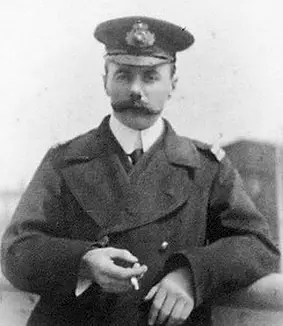
Titanic's Dr Simpson - Lightoller wrote they
said "Goodbye, old man"
"I may say I was practically the last man to speak to Dr Simpson, and on this occasion he was walking along the boat deck in company with Mssrs. McElroy, Barker, Dr O'Loughlin and four assistant pursers. They were all perfectly calm in the knowledge that they had done their duty and were still assisting by showing a calm and cool exterior to the passengers. Each one individually came up to me and shook hands. We merely exchanged the words 'Goodbye, old man'. This occurred shortly before the end and I am not aware that he was seen by anyone after. With deepest sympathy for you in the loss of your friend."
Another final sighting was possibly near the gymasium on the starboard side, although at present the source of this is unknown: "Purser McElroy was last seen standing on the Boat-Deck near the gymnasium, beside mail clerk Mr William Logan Gwinn, giving him words of encouragement, for what was about to happen, both men died in the sinking of the R.M.S. Titanic." (Encyclopedia Titanica)
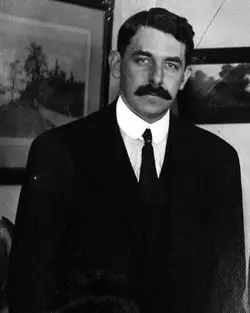
McElroy was last seen with American
postal clerk William Gwynne (or Gwinn).
(Credit: findagrave.com)
A similar account also places McElroy ("popular purser") with the tall (6'4") 37-year-old American postal clerk Gwinn (or Gwynne), noting McElroy's coolness and also describing the purser as "sucking a lemon." Whether this is to be taken literally is unclear. The British idiom "sucking a lemon" indicates someone who is in a sour or negative mood, which does not align with the overall description of McElroy as "characteristic sang-froid and coolness ... cheery manner," so may indicate it was literally a lemon, unless it is an awkward means of saying that McElroy was looking serious. In an alternate account in The Morning Leader of 29th April 1912 there is a similar description except "the doctors and chief engineer were seen smoking cigarettes sitting in deck chairs."
Purser McElroy's Coolness
Another stirring story concerns the closing chapter of the career of Chief
Purser McElroy ... From the outset McElroy was kept busily employed rousing
the passengers and then encouraging them to face the ordeal that awaited them.
From one to the other he went with characteristic sang-froid and coolness, his
cheery manner giving heart to many. Here he stopped to fasten a lifebelt more
securely: there it was to persuade a passenger to put on warmer clothing.
Then he conducted them to the boats, as the last one drew away from the
ship of the Titanic sailors saw the popular purser standing calmly on the topmost
deck sucking a lemon. By his side stood Mr. Wm.Gwynne, one of the United
States postal clerks, and together they awaited with complacency the end.
(Western Daily Mercury 29 April 1912, “Titanic – The Homecoming”
“Tales from the Lapland”
by Dr. Paul Lee)
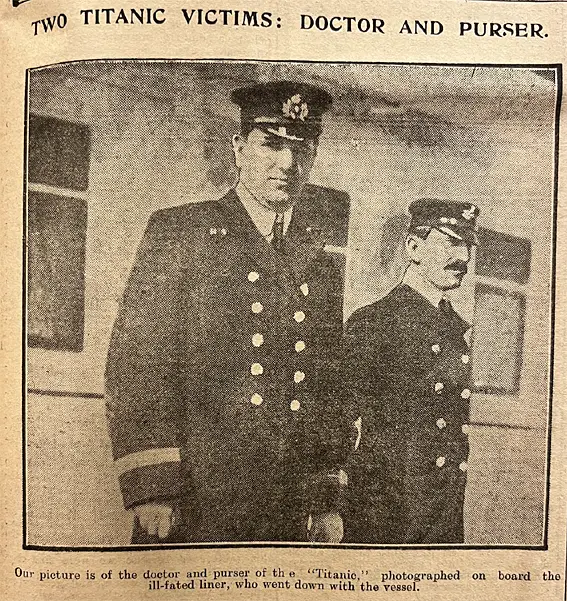
Chief Purser Hugh McElroy and who appears to be Dr John Simpson, the Assistant Surgeon, aboard Titanic's boat deck. They were both last seen standing on the boat deck. (Illustrated Chronicle, 23 April 1912)
(Click to enlarge)